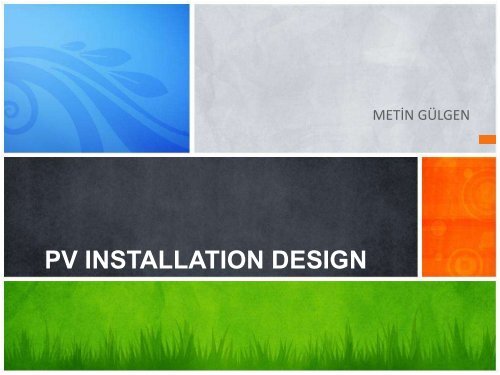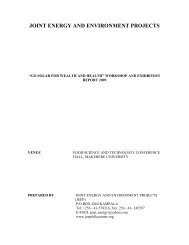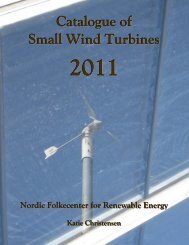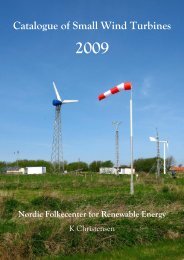PV and Solar Thermal Installation in Turkey
PV and Solar Thermal Installation in Turkey
PV and Solar Thermal Installation in Turkey
Create successful ePaper yourself
Turn your PDF publications into a flip-book with our unique Google optimized e-Paper software.
<strong>PV</strong> INSTALLATION DESIGN<br />
METİN GÜLGEN
Yearly sum of global irradiation <strong>in</strong> <strong>Turkey</strong><br />
Location: Antalya, TURKEY
Yearly sum of global irradiation <strong>in</strong> Antalya
Average meteorological datas for Antalya<br />
Months Av. Temp. (°C) Av. Max. Temp.<br />
°C<br />
Av. M<strong>in</strong>. Temp. °C Av. <strong>Solar</strong> Irrad.<br />
(h/d)<br />
January 9.6 15.0 5.6 5.3 12.4<br />
February 9.9 15.3 5.7 6.1 10.4<br />
March 12.2 17.9 7.4 6.9 9.0<br />
April 15.8 21.4 10.6 8.0 7.3<br />
May 20.3 25.9 14.5 9.9 5.4<br />
June 25.3 31.3 19.0 11.6 2.9<br />
July 28.3 34.4 22.1 12.0 1.5<br />
August 27.8 34.3 21.8 11.6 1.5<br />
September 24.3 31.3 18.6 10.0 2.0<br />
October 19.5 26.9 14.5 8.1 5.6<br />
November 14.2 20.8 9.8 6.3 7.8<br />
December 10.8 16.3 6.8 4.9 11.5<br />
Av. Numb. Ra<strong>in</strong>y<br />
Days
Diagram of grid connected <strong>PV</strong> system
Diagram of grid connected <strong>PV</strong> system
The major components of a grid connected system<br />
• 1. the modules mak<strong>in</strong>g up the solar array convert the sun’s energy to<br />
direct current (DC) electrical energy.<br />
• 2. the mount<strong>in</strong>g system supports the solar array at the desired angle<br />
to the sun.<br />
• 3. the power center, custom-configured for the system, will <strong>in</strong>clude<br />
a. a low-distortion <strong>in</strong>verter to transform DC <strong>in</strong>to the alternat<strong>in</strong>g<br />
current (AC) used by most of our appliances <strong>and</strong> by the utilities;<br />
b. an <strong>in</strong>terconnect with <strong>in</strong>com<strong>in</strong>g utility power;<br />
c. a connection to your breaker panel.<br />
• 4. the system data monitor shows how much energy is flow<strong>in</strong>g <strong>in</strong><br />
from the energy sources <strong>and</strong> how much is flow<strong>in</strong>g out to the loads.<br />
• 5. the balance of system hardware consists of wir<strong>in</strong>g, term<strong>in</strong>ations,<br />
Ground Fault Interrupter, surge protections, DC <strong>and</strong> AC<br />
disconnects, etc.
<strong>PV</strong> Modules-Bosch c-Si M60
<strong>PV</strong> Modules-Bosch c-Si M60
Inverter-SMA SB 3300
Inverter-SMA SB 3300
Series Connection of <strong>PV</strong> Panels
Balances <strong>and</strong> Ma<strong>in</strong> Results (<strong>PV</strong>Syst)
Energy Production (<strong>PV</strong>Syst)
Daily System Output Energy (<strong>PV</strong>Syst)
System Losses (<strong>PV</strong>Syst)
Performance Ratio (<strong>PV</strong>Syst)
<strong>Solar</strong> Water Heat<strong>in</strong>g
<strong>Solar</strong> Water Heat<strong>in</strong>g <strong>in</strong> <strong>Turkey</strong><br />
• Approximately 20 million m 2 solar collectors under use.<br />
• Flat-plate solar collectors are commonly used. Evacuated tubes are<br />
also used.<br />
• Most of them are used <strong>in</strong> Mediterranean, Aegean <strong>and</strong> Marmara<br />
region.<br />
• Annual solar collector production capacity is nearly 1 million m 2<br />
• 10% of the production is be<strong>in</strong>g exported.
Flat-Plate <strong>Solar</strong> Collectors<br />
Flat-Plate <strong>Solar</strong> Collector<br />
Flat-plate collectors are the most<br />
common solar collector for solar<br />
water-heat<strong>in</strong>g systems <strong>in</strong> homes<br />
<strong>and</strong> solar space heat<strong>in</strong>g. A typical<br />
flat-plate collector is an <strong>in</strong>sulated<br />
metal box with a glass or plastic<br />
cover (called the glaz<strong>in</strong>g) <strong>and</strong> a<br />
dark-colored absorber plate.<br />
These collectors heat liquid or air<br />
at temperatures less than 80°C.
Evacuated-Tube Collectors<br />
Evacuated-Tube <strong>Solar</strong> Collector<br />
Evacuated-tube collectors can<br />
achieve extremely high<br />
temperatures (170°F to 350°F).<br />
However, evacuated-tube<br />
collectors are more expensive<br />
than flat-plate collectors, with unit<br />
area costs about twice that of flatplate<br />
collectors.
Water Heat<strong>in</strong>g System
Thank you for your attention…

















